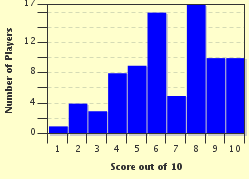Quiz Answer Key and Fun Facts
1. Which of the following created the need for a Restoration in England?
2. Only two kings ruled England during the period known as the Restoration. They were part of which royal house?
3. Charles II issued the Declaration of Breda before he reclaimed the throne of England. Which of the following was NOT part of the proclamation?
4. On May 29, 1660, Charles II returned to London. This day was made a public holiday. What was it called?
5. On May 8, 1661, after the coronation of Charles II on April 23, 1661, a new Parliament convened for the first time. What was it called, a name that perhaps reflected its Royalist attitude?
6. During the Restoration many of the people who had been involved in the death of Charles I were found guilty of high treason and executed.
7. What religious change was made during the Restoration in England?
8. Which of the following best describes the general attitude in Restoration England during the reign of Charles II?
9. The religious policies of James II, the younger brother of Charles II, played a vital role in his demise. What happened?
10. Which of the following events ended the Restoration period in English history?
Source: Author
ponycargirl
This quiz was reviewed by FunTrivia editor
bloomsby before going online.
Any errors found in FunTrivia content are routinely corrected through our feedback system.

